THE THREE CITIES
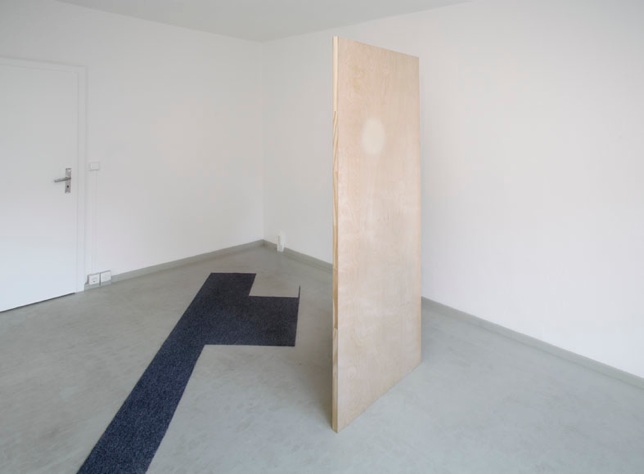
Gedi Sibony
The World is Neither Not Nor, 2005,
Wood, Carpet, Spray Paint, Variable Size (Installation view)


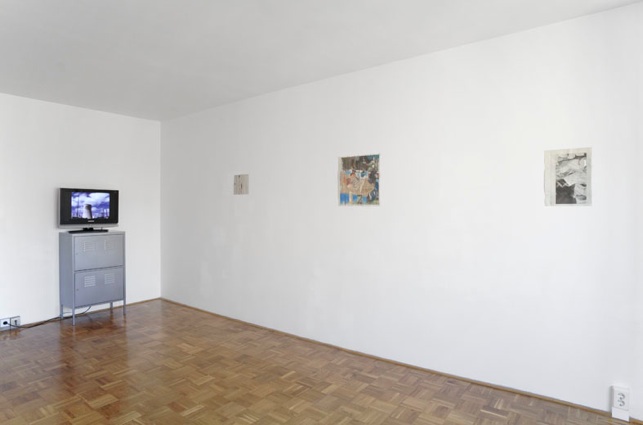
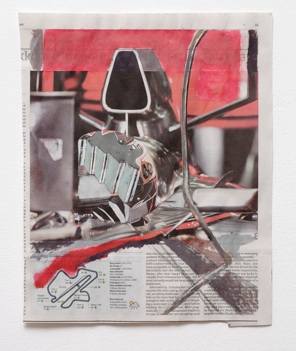
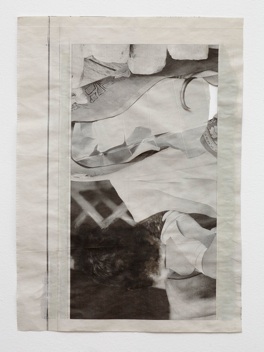

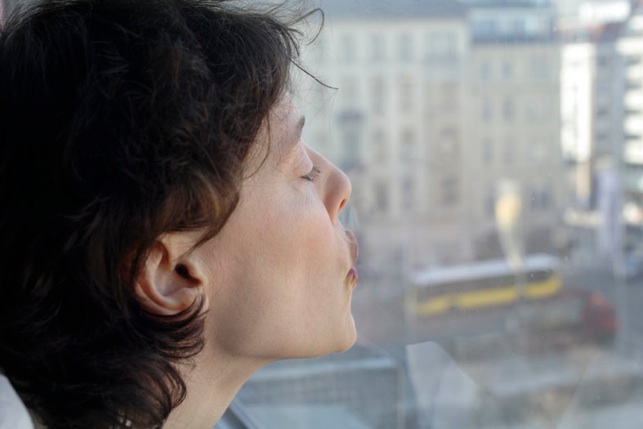
Andreas Slominski
Eine Tischplatte küssen, 2006
Performance with Anna-Catharina Gebbers, Gyonata Bonvicini and Paolo Zani
at Bibliothekswohnung and Friedrichstadtpalast, Berlin
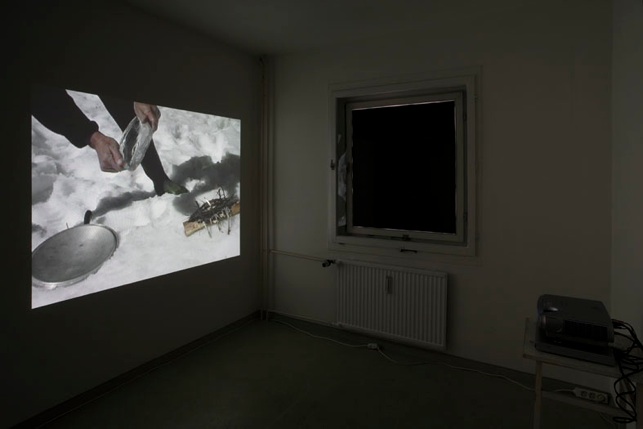



Lucile Desamory
Clone Zone, 2000
In collaboration with Patricia Gélise
Super 8/DVD, B/W, 13 min.
(Screenshot)

THE THREE CITIES: BERLIN - THE APARTMENT
a site specific performance art, video art and exhibition project with
ALEX CECCHETTI (Milan), LUCILE DESAMORY (Berlin/Brussels), PAUL KOS (San Francisco),
GEDI SIBONY (New York), ANDREAS SLOMINSKI (Berlin/Hamburg), TONY SWAIN (Glasgow)
invited by Gyonata Bonvicini, Anna-Catharina Gebbers and Paolo Zani
23 – 25 March 2006, 11:00 – 15:00
Anna-Catharina Gebbers | Bibliothekswohnung
Ziegelstraße 2, Apt. #06.03 | D-10117 Berlin-Mitte
THE THREE CITIES: BERLIN, MILAN, LONDON is an ongoing international performance art and exhibition project curated by Gyonata Bonvicini, Anna-Catharina Gebbers and Paolo Zani.
THE THREE CITIES: BERLIN, MILAN, LONDON
The project involves three curators who live and work in different European cities (GYONATA BONVICINI in London, ANNA-CATHARINA GEBBERS in Berlin and PAOLO ZANI in Milan).
Each of the three curators asks the other two to come to his or her home town and organise a joint exhibition at a temporary venue. The venues reflect the site-specific features of each city and at the same time demonstrate their own spatial peculiarities, which in turn influence the selection of artists invited to participate and the works they present. The exhibitions are held during temporary art events that attract visitors from all over the world, and can thus also be read as a metaphor for the hype currently surrounding the art world.
In an age of globalisation, borders seem to pose less of an problem as far as economic mobility and the freedom to travel are concerned, but clearly still exist in terms of wealth, health care and natural resources. Moreover, borders such as that between reality and fiction are discussed not only in art but also with regard to political propaganda, institutional and personal organisation, or public and private space. Borrowing its title from a series of novels by Emile Zola, this performance art and exhibition project explores the specific social, cultural, functional, spatial and material contexts and relations that distinguish the various venues in which it is being staged.
The fact that each of the three curators is based in one of the three cities creates a fluid balance between a deeper knowledge of the local territory and an openness to different realities, such as those brought by the two other curators to each venue.
BERLIN: THE APARTMENT
The intimate environment of the apartment epitomizes the continuous intertwining between private and public dimension. Furthermore the peculiar location of the venue marks several borders of different origin and predestines it for a privileged position of observation.
The library apartment of the curator Anna-Catharina Gebbers is facing Friedrichstadtpalast, which used to be the largest stage for GDR-spectacles/events, dance revues etc. and, before it was rebuilt here, was formerly directed by the German theatre legend Max Reinhard. The apartment is also situated near theatres like Berliner Ensemble, Metropol Theater, Deutsches Theater , Cabaret Distel and right across Tränenpalast, a building that had lived a long history that always involved borders. Built in the same time as the Berlin Wall, until 1989 Tränenpalast used to be the customs clearance room at the station Friedrichstraße. Here the East-Berliners had said their good-byes to their visitors from the West, it was a checkpoint between two worlds.
But Friedrichstraße also used to be the famous promenade of the Roaring Twenties, the entertainment spot of the metropolis. An opening night in the Apollo theatre was one of the most important society events. The Wintergarten – the quintessence of varieté – witnessed the birth of cinema with the world première of Max Skladanowskis “Theatre of Living Photographs”. Whether you loved the luxury or rather the folkloristic way – the Friedrichstraße would have been the place to entertain you, and the station Friedrichstraße (built in 1882) was a border crossing between the reality of daily life and a glamorous time out.
The apartment in Ziegelstrasse is also located between Reichstag, Bundestag, Bundeskanzleramt, Brandenburger Tor on the one hand side, and the area of the galleries in Berlin Mitte and the institutions at Museumsinsel on the other side. This location defines the venue’s condition as a privileged point of observation. It yearns/demands for comments on the theatrality or sometimes painful reality of art and politics.
The exhibitions regularly organized by Anna-Catharina Gebbers here, always take place for only four hours. Due to this fact those events are more performances of exhibitions than normal exhibitions. They expose the extravagant, mannered quality of the current artworld, with its fleetingness, the crossing of art and capital, the clash of utopia and reality, the fear to miss something, and involve also the Berlin tradition of Salons and apartment exhibitions.
Some of the different and more or less successful ways of feeling or making yourself comfortable at home will be shown in the apartment. Making up or tearing down borders between realities represented a fundamental issue for the selection of artists for this chapter of the tripartite exhibition project.
BERLIN: THE ARTISTS
ALEX CECCHETTI
born 1976, Terni, Italy. Lives in Milan.
Paintings, Videos
The film „Farinacci“, 2005, shown in the exhibition in Berlin is portraying a man from Umbria. Following the oral history told by Farinacci, the past reality of his hometown with all its mystical, and sometimes ugly facts is revived.
In his video works and drawings, Cecchetti pairs harsh violence with a visionary and poetic aesthetic. His works play successfully on the effect of ambiguity. The short feature films show losers as protagonists, characters coming from the ‘province’ who made their revolution, combating against the central power: St. Francis (a trilogy is dedicated to him), Don Quixote, Christ, become for Cecchetti the vehicle through which it becomes possible to read and re-interpret reality, by using continuous metaphors and shifts of meaning. His landscape paintings and drawings give a gloomy and shadowy vision of nature, emphasizing the loneliness of the spectator before a falsely static atmosphere, where in reality we get the sensation that something is always just about to happen.
LUCILE DESAMORY
born 1977, Brussels. Currently living in Berlin.
Films, Collages, Music Performances.
The films “3. Clone Zone”, 2000, and “à l’ombre de l’hyperboloïde”, 2004, present an ambiguous, surrealistic world in the twilight zone at home between dream, fiction, reality, utopia, humour and serious fear.
Desamory creates an audiovisual world mixing paper collages, stop motion and musical films. Working with found material such as stock sport photography and encyclopaedic illustration Desamory produces rich and dreamlike pictures which in total create a document to sensitised human corporeality. Her silhouette works on paper formally bring together the attitude of stop motion and visual art. Often three dimensional they play with the aesthetics of picture-books, sculptures, galanty shows and the pre-stages of filmmaking.
Formerly running a night club in Brussels, Desamory has shown her films and performed live across Europe. “Jigsaw (jeu de société)” currently shown at Galerie Meerrettich, Berlin, presents a collaboration by Lucile Desamory, Lucy McKenzie and Birgit Megerle.
PAUL KOS
born 1942, Rock Springs, Wyoming. Lives in San Francisco.
Installations, Videos, Perfomance Art.
Featured in the show in Berlin is the video work “Ice/Fire”, 2004. The film shows Kos using an ice lens to switch a fire – one of the oldest symbols of shelter and home for the human being.
Kos is known for his special entry of the poetry of material. One of the artist's best-known works is an installation from 1970, where Paul Kos placed about a dozen standing microphones around two blocks of ice. He called the work “The Sound of Ice Melting”. The photograph documenting the event is a fine absurdist image: It calls to mind the old photographs of politicos speaking into a bristling array of microphones, only here the microphones resemble birdlike creatures craning to hear what the blockhead will say.
Paul Kos has been a highly influential artist in the Bay Area for well over three decades. In the late 1960s and early 1970s he was one of the major figures on the early conceptual art scene, notable especially for his early experimental video works and seemingly simple but technically innovative sculptural installations, which generally featured evocative audio or video components. He was one of the first to incorporate video into interactive installations.
GEDI SIBONY
born 1973, New York City. Lives in New York.
“The World is Neither Not Nor”, 2005, occupies a whole room in the apartment by using a door leaf, a piece of carpet and spray paint to deconstruct an apartment and to divide space.
Sibony’s so called “guerilla formalism” works with materials he finds in places like supply closets, mail rooms, cubicles, which he turns into rough-hewn, weirdly elegant sculptures. In his works arte povera, Richard Tuttle, and formalistic methods assonant. “I want to convey a kind of discovery by moving through things the way allegory incorporates various energies in a harmonious environment. This might be understood as an alignment of symbolic thinking and material tactility.” (ArtForum, Sept. 2004). Sibony seems concerned with tracing the process by which ‘pure’ form transmutes itself into symbol. But rather than conceive of this process as the basis for referential gamesmanship or as a dreaded entropic slippage, he posits it as the opening up of new realms of possibility. His works keep with them always a sense of fragility and precarity.
An installation by Gedi Sibony is currently shown at the Whitney Biennial, New York.
ANDREAS SLOMINSKI
born 1959, Meppen, Germany. Lives in Berlin and Hamburg, Germany.
Installations, Sculptures, Performances, Photographs, Paintings, Drawings.
Dedicated to the special location of the apartment and on the specific occasion of the exhibition, Andreas Slominski has invented a performance – gone by, as always, when the spectators arrive.
Slominski is known for works which announce him as a trickster and points up the ludic element which runs through his projects. A common thread is the role of narrative and in many instances the object exhibited is the culmination of an elaborate sequence of events. Slominski often covers his tracks, chapters of the narrative vanish, leaving only some very perplexing signs. Slominski considers the relationship between figures and quantities, between the present and the past, between the facts and the made up, between the small every day live and the unconceivable from a variety of perspectives – as abstractions, as mathematical elements and as the components of communities and society as a whole.
Andreas Slominski’s new, again perplexing, polystyrene works will be shown in a solo exhibition at Metro Pictures, New York, in May.
TONY SWAIN
born 1967, Lisborn. Lives in Glasgow.
Drawings, Collages, Music.
The exhibition present a series of new paintings on newspaper and collages, which seem to transfer urban surroundings and housings to a strange, fantastical and private world.
Swains works on paper derive their material source from newsprint and magazines. His paintings have a strange air of familiarity. Seemingly random patterns are produced from a starting point as oblique as a shadow or colour on the newsprint. The final result being at times a surreal, fantastical landscape or a depiction of an intimate, but unrecognizable object. When you study the works, it seems as though Swain is involving you in his private surreal world, with influences from music and from the built environment. The original print and Swain’s finely painted transcription become indistinguishable. It is through this process that Swain manages to invert the print material with unusual and unassociated surreal attributes. The resulting collage has a part fantasy painting and part realist ‘photoprint’ quality.
The musician and artist Tony Swain transforms in his paintings the specific character of music, which is depending on or only existing in time, and the momentariness of the up-to-dateness of the daily news.
…………………………………………………………………………………………………
Upcoming:
Milan: The Factory
22 September 2006 (“START Miland”-weekend)
Former Fabbrica Presbitero, Via Farini 57, 20159 Milan (Isola)
With: Steven Claydon (1969, Great Britain), Claire Fontaine (France/Great Britain), Ruth May (1974, Germany), Gian Domenico Sozzi (1960, Italy), Josh Smith (1976, USA), Dirk Stewen (1972, Germany)
London: The Warehouse
10 October 2006 (on the eve of the professional day of “Frieze Art Fair”)
3 Durham Yard, Teesdale Street, London E2 6QF (Bethnal Green)
With: Guy Ben-Ner (1969, Israel), Ulla von Brandenburg (1974, Germany), Pablo Bronstein (1977, Argentina), Farid Rahimi (1974, Switzerland), Christoph Schlingensief (1960, Germany), Sue Tompkins (1971, Great Britain)
…………………………………………………………………………………………………
The Curators would like to thank the participating artists, David Gryn/Artprojx and Art:Concept, Paris.
BERLIN: THE APARTMENT
ALEX CECCHETTI, LUCILE DESAMORY, PAUL KOS, GEDI SIBONY, ANDREAS SLOMINSKI, TONY SWAIN
invited by Gyonata Bonvicini, Anna-Catharina Gebbers and Paolo Zani
23 – 25 March 2006, 11:00 - 15:00
Anna-Catharina Gebbers | Bibliothekswohnung, Ziegelstr. 2, 10117 Berlin